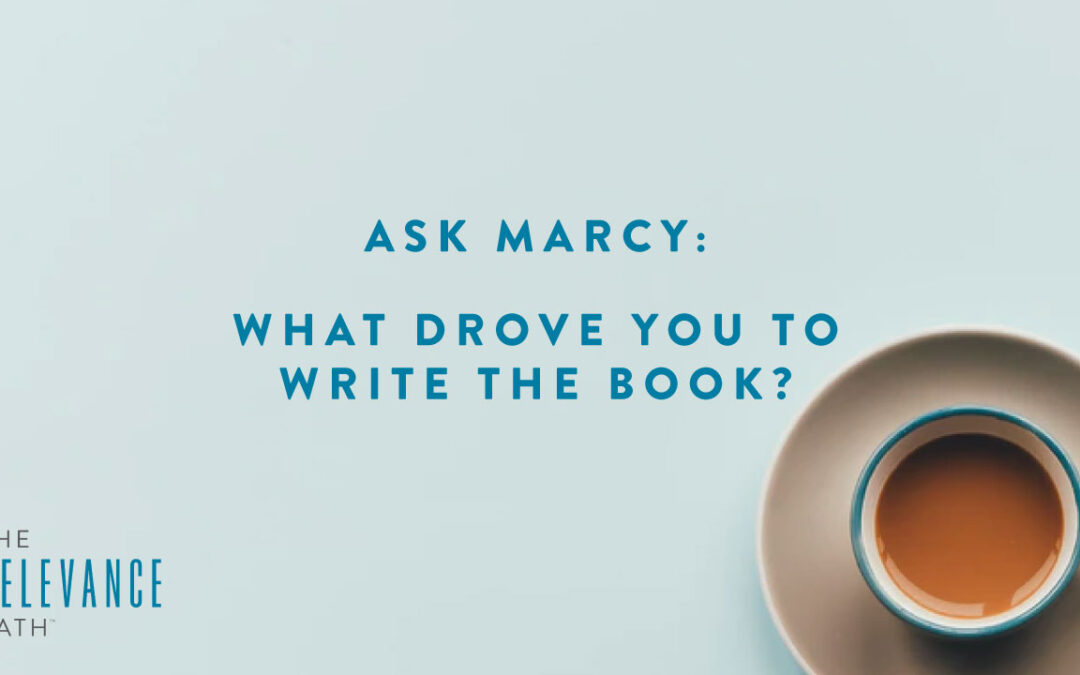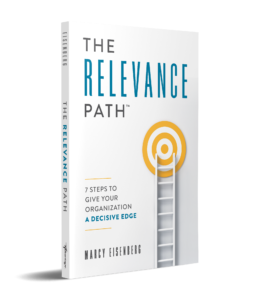This post is part of a series called “Ask Marcy,” where The Relevance Path readers can submit questions directly to our author, Marcy Eisenberg.
Anyone could write a book, right? But not everyone can write a book that people want to read. We got this question from one of our launch party attendees and we’ve got a recording to show for it:
Charles D.: What drove you to write the book?
Marcy:
So, the reason I wrote the book was because over the last 13 years, we kept on having a lot of really amazing successes on site. Time and time again, our clients and our partners alike in industry kept saying the same thing: why are you able to succeed here when no one else can? So, it really forced us to take a step back and really think “Why is that?”
We polled the team and recognized that we actually had a series of processes and very similar activities that we could formalize into a true blue methodology. So, fast forward. Here we are with the Relevance Path in hand and we are super excited to share it with the world so everybody can benefit from it.
Great question.
So, that’s the simple answer. The reality took a bit longer. And, the reality was that we actually used The Relevance Path to create the book as well!
The commonalities were the ingredients that would become our secret sauce. With our ingredients identified, we asked ourselves the hard question: so what? What can we do with these ingredients? Can we create a delicious recipe to help our clients? Would people be interested in learning our recipe? How do we get this recipe to the masses?
The short answer: write a book.
Here’s why: After hearing the feedback from so many sources, I started reviewing (one of the tools/”steps” in RELEVANCE, that is so often missed but is critical to project success) with my team. First, we documented our successes, most of which became use cases in the book. Pathorians are fairly modest so they didn’t think they were doing anything special. They were just doing what they do best: help the customer succeed.
We realized there was a large relevance gap (methodologies and knowledge on how we knew how to succeed that our customers could benefit from but didn’t have those tools in their arsenal… yet). So, one of the ways to help transfer that knowledge to our customers and enable the mission was to write the book.
We then engaged, listened, and enhanced the quality of information in the book, and even provided visuals, by working with fellow Pathorians to refine the information and ensure that our clients could really benefit from the information in the book (who wants to read a bunch of nonsense? Not us!).
Next, we analyzed those successes to find commonalities. We realized that Pathorians are multi-faceted, allowing them to connect with customers on multiple levels. We had analysts working in IT offices, helping design systems to better support mission. We had IT professionals working in mission spaces, helping to automate or streamline analytic processes to better support them. In addition, all Pathorians possessed a high degree of empathy that allowed them to really connect and communicate with their customers and build trust.
Since it was my first time writing a book, it was quite the journey. My team and I worked closely for several years, trying to articulate a recipe that became the seven steps of The Relevance Path. Then we stepped into the unknown world of publishing. What was interesting was that we had to use The Relevance Path with the editor too, since they didn’t understand the content in the book or why our customers have continually found that content valuable.
So we demonstrated the value of the content to the editors, helping them to understand the nuances in the book, and together we even uncovered hidden needs, obstacles, and goals for project success. This included providing free project success templates for readers to use (a hidden need), overcoming complex subject matter in a breezy way that our readers could resonate with (a hidden obstacle), and creating a book that organizations, teams and people can use for meeting and exceeding project goals ever known or thought possible (a project goal).
The end result was a book that we’ve received great reviews on and people have even said they’ve successfully utilized (or started using) in their own projects and daily activities, including a project manager who’s using the tips and tricks for helping relate to end customers, and a Financial Advisor who’s now aware of strong communication practices and awareness of cognitive biases when working with his clients.
Finally, with the book’s publication, we had to celebrate.
Have a question for our author? Drop it in the comments below for a chance to be featured!



Trackbacks/Pingbacks